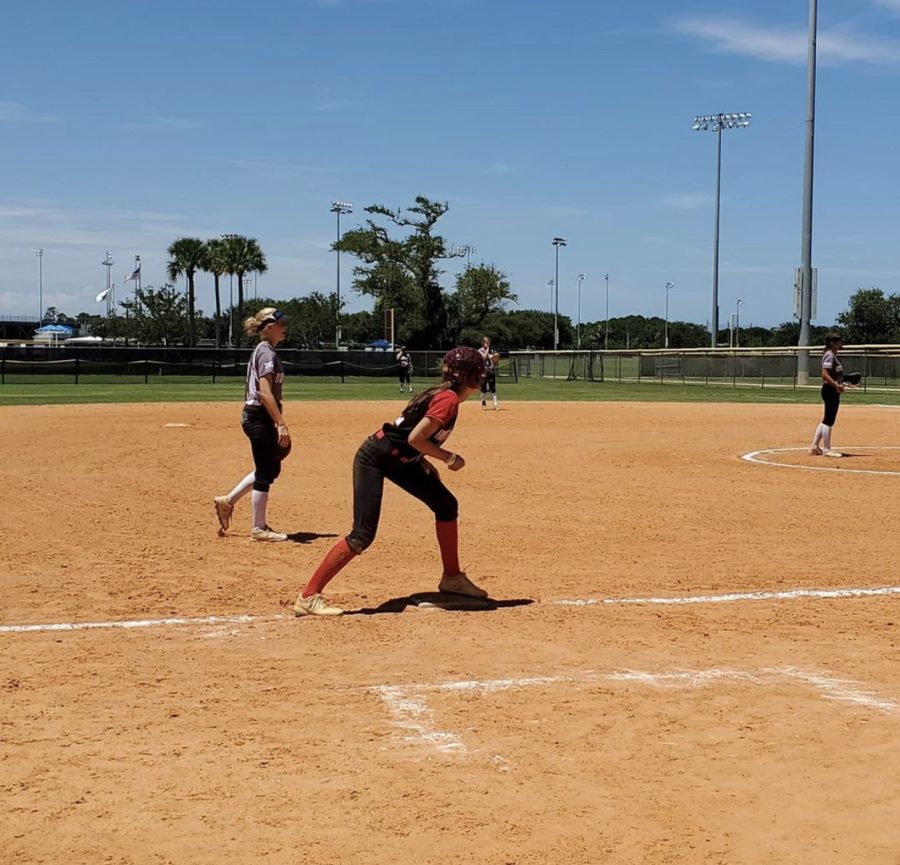Student athletes stay active during quarantine
Photo provided by: Ella Christopher
Junior Ella Christopher gets ready to score from third base during a showcase tournament in Myrtle Beach, South Carolina this past summer. Travel softball was at a standstill to slow the spread of COVID-19. Tournament organizations implemented new regulations to get the athletes playing again, as summer is a crucial time for college recruitment. “I went to Myrtle Beach in South Carolina because I’m trying to get recruited for college,” Christopher said.
September 28, 2020
Student athletes were faced with difficulties due to the abrupt disruption of spring and summer competitive sports. During the state mandated quarantine, many of those athletes had to find ways to stay on top of their game while still staying safe.
At the beginning of quarantine, it was hard for athletes to do anything related to their sport. Many facilities were shut down in an attempt to slow the influx of COVID-19 cases, so athletes had to find alternate ways to train on their own. The restriction on the number of people at social gatherings occurred in March when an Executive Order was placed that limited people to a maximum of ten people per group. On April 1, Governor Ron DeSantis and the Florida Department of Health enforced a statewide stay-at-home order. The stay-at-home order lasted thirty days and prohibited people from leaving their homes for anything that was unessential. This impacted all sports because the athletes were unable to meet with coaches or their team causing the tournaments to be delayed.
“The fields were closed and so were most parks and batting cages,” junior varsity baseball Coach Steve Golden said. “Some of them [baseball players] would partner up and throw in their neighborhood and hit off of the tee in their garage.”
Not only did athletes have trouble finding places to train, they also struggled with maintaining the rigor of high school sports. During the school year, the swim team typically trains twice a day to stay in shape for the meets, but because of the closing of many public swimming pools, the athletes had to get creative and adapt.
“I feel as if I regressed over the break because there were no swimming pools that were open during most of quarantine,” sophomore Paula Garcia said. “However, I did different workouts, including running and some swimming in the pool at my house.”
The United States Specialty Sports Association (USSSA), a well-known softball and baseball tournament organization, put in place many new restrictions for the fans, athletes, and coaches that were attending their tournaments. For example, USSSA implemented designated seating and required the use of masks for fans. They also eliminated handshakes between teams after the game.
“The travel ball tournaments I attended this summer varied by venue and organization,” Golden said. “Some required fans to wear masks, some only allowed spectators beyond the outside fence, some enforced no restrictions at all. All the tournaments I am aware of required a parent or guardian signed waiver for the players.”
Although there were many setbacks, the extensive safety measures in competitions allowed student athletes to feel safe in continuing to compete in the sport they love.
“If I could take away one thing from quarantine, it would be how much we take the game for granted and how lucky we were to be able to play over summer,” junior Ella Christopher said. “It made me realize that any game could be your last to play to your full ability.”






